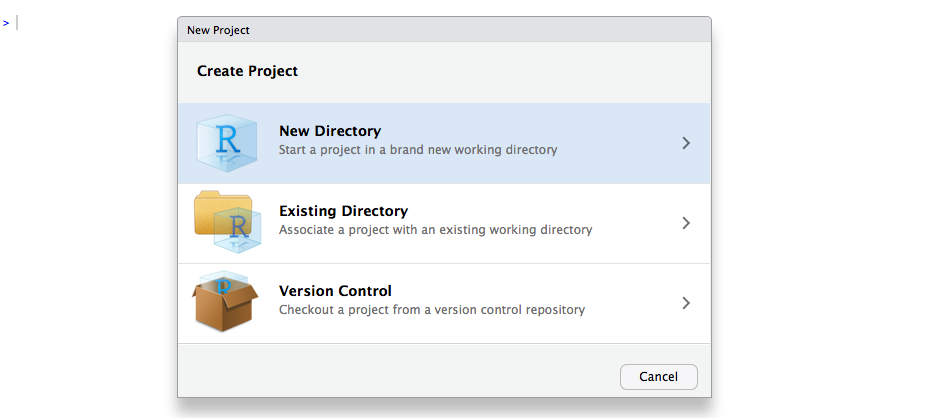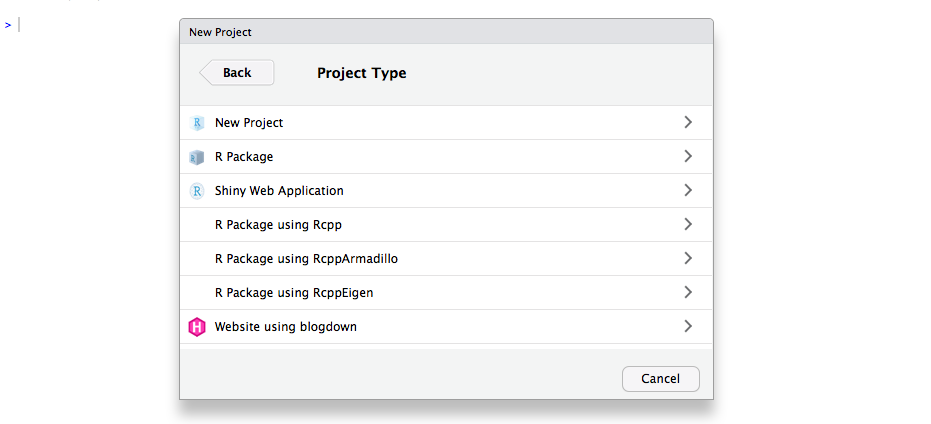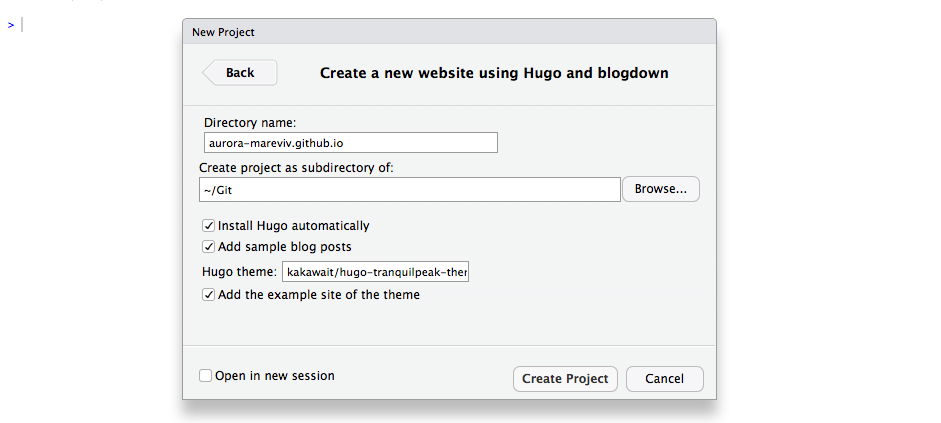The blogdown R package
Finally, -after 24h of failed attempts-, I could get my favourite Hugo theme up and running with R Studio and Blogdown.
After exploring some alternatives, like Shirin’s (with Jekyll), and Amber Thomas advice (which involved Git skills beyond my basic abilities), I was able to install Yihui’s hugo-lithium-theme in a new repository.
However, I wanted to explore other blog templates, hosted in GiHub, like:
- gcushen/hugo-academic
- jpescador/hugo-future-imperfect and
- kakawait/hugo-tranquilpeak-theme
- Or this one kishaningithub/hugo-creative-portfolio-theme
The three first themes are currently linked in the blogdown documentation as being most simple and easy to set up for unexperienced blog programmers, but I hope the list will grow in the following months. For those who are willing to experiment, the complete list is here.
Finally I chose the hugo-tranquilpeak theme, by Louis Barranqueiro & Thibaud Leprêtre, for which I mostly followed Tyler Clavelle’s entry on the topic. This approach turned out to be easy and good, given some conditions:
Contrary to Yihui Xie’s advice, I felt brave enough to choose github.io to host my blog, instead of Netlify (I loved my desktop integration with GitHub, so it was interesting for me not to move to another service for my static content). However it is possible that in the future I change the hosting.
- In my machine, I installed Blogdown & Hugo using R studio (v 1.1.336).
- In GiHub, it was easier for me to host the blog directly in my main github pages repository (always named [USERNAME].github.io), in the master branch, following Tyler’s tutorial.
- I have basic knowledge of html, css and javascript, so I didn’t mind to tinker around with the theme.
My custom styles didn’t involve theme rebuilding. At this moment they’re simple cosmetic tricks.
The steps I followed were:
Git & GitHub repos
- Setting a GitHub repo with the name [USERNAME].github.io (in my case aurora-mareviv.github.io). See this and this.
- Create a
gitrepo in your machine:- Create manually a new directory called [USERNAME].github.io.
- Run in the terminal (Windows users have to install
gitfirst):
cd /Git/[USERNAME].github.io # your path may be different git init # initiates repo in the directory git remote add origin https://github.com/[USERNAME]/[USERNAME].github.io # connects git local repo to remote Github repo git pull origin master # in case you have LICENSE and Readme.md files in the GitHub repo, they're downloaded - You can add a .gitignore text file to the root directory of your repo. This tells
gitwhat files not to add to the repo, even if they are into the folder. One example of .gitignore file is this. - For now, your repo is ready. We will now focus in creating & customising our Blogdown.
RStudio and blogdown
We will open RStudio (v 1.1.336, development version as of today).
- First, you may need to install Blogdown in R:
install.packages("blogdown")- In RStudio, select the Menu > File > New Project following the lower half of these instructions. The wizard for setting up a Hugo Blogdown project may not be yet available in your RStudio version (not for much longer probably).

Creating new Project

Selecting Hugo Blogdown format

Selecting Hugo Blogdown theme

A config.toml file appears
Customising paths and styles
Before we build and serve our site, we need to tweak a couple of things in advance, if we want to smoothly deploy our blog into GitHub pages.
Modify config.toml file
To integrate with GiHub pages, there are the essential modifications at the top of our config.toml file:
- We need to set up the base URL to the “root” of the web page (https://[USERNAME].github.io/ in this case). We use the dot instead of “/” to allow tag URLs to link properly.
- By default, the web page is published in the “public” folder. We need it to be published in the root of the repository, to match the structure of the GitHub master branch:
baseurl = "/./"
publishDir = "./"- Other useful global settings:
draft: false # if set to true, changes will not be published
ignoreFiles = ["\\.Rmd$", "\\.Rmarkdown$", "_files$", "_cache$"]
enableEmoji = trueImages & styling paths
We can revisit the config.toml file to make changes to the default settings.
The logo that appears in the corner must be in the root folder. To modify it in the config.toml:
picture = "logo.png" # the path to the logoThe cover (background) image must be located in /themes/hugo-tranquilpeak-theme/static/images. To modify it in the config.toml:
coverImage = "myimage.jpg"We want some custom css and js. We need to locate it in /static/css and in /static/js respectively.
# Custom CSS. Put here your custom CSS files. They are loaded after the theme CSS;
# they have to be referred from static root. Example
customCSS = ["css/my-style.css"]
# Custom JS. Put here your custom JS files. They are loaded after the theme JS;
# they have to be referred from static root. Example
customJS = ["js/myjs.js"]Custom css
We can add arbitrary classes to our css file (see above).
Since I started writing in Bootstrap, I miss it a lot. Since this theme already has bootstrap classes, I brought some others I didn’t find in the theme (they’re available for .md files, but currently not for .Rmd)
alert-danger
alert-warning
alert-success
alert-info
Here is my custom css file to date:
/* @import url('https://maxcdn.bootstrapcdn.com/bootswatch/3.3.7/cosmo/bootstrap.min.css'); may conflict with default theme*/
@import url('https://fonts.googleapis.com/icon?family=Material+Icons'); /*google icons*/
@import url('https://cdnjs.cloudflare.com/ajax/libs/font-awesome/4.7.0/css/font-awesome.min.css'); /*font awesome icons*/
.input-lg {
font-size: 30px;
}
.input {
font-size: 20px;
}
.font-sm {
font-size: 0.7em;
}
.texttt {
font-family: monospace;
}
.alert {
padding: 15px;
margin-bottom: 20px;
border: 1px solid transparent;
border-radius: 4px;
}
.alert-success {
color: #3c763d;
background-color: #dff0d8;
border-color: #d6e9c6;
}
.alert-danger,
.alert-error {
color: #b94a48;
background-color: #f2dede;
border-color: #eed3d7;
}
.alert-info {
color: #3a87ad;
background-color: #d9edf7;
border-color: #bce8f1;
}
.alert-gray {
background-color: #f2f3f2;
border-color: #f2f3f2;
}
/*style for printing*/
@media print {
.noPrint {
display:none;
}
}
/*link formatting*/
a:link {
color: #478ca7;
text-decoration: none;
}
a:visited {
color: #478ca7;
text-decoration: none;
}
a:hover {
color: #82b5c9;
text-decoration: none;
}An example of the alert-danger class:
<div class="well alert alert-danger text-center">
<span class="fa fa-minus-circle"></span> alert-danger
</div>Also, we have font-awesome icons!
Update! Hugo shortcodes in .Rmd !
Searching through blogdown/issues in GitHub, I found this good trick by Yihui:
You can add Hugo shortcodes if you wrap them with the function htmltools:HTML
htmltools::HTML("{{< hl-text danger >}}
this is a highlighted danger text
{{< /hl-text >}}")Custom javascript
We can also add really cool functions to enhance our post. Click in the red button below!:
alert-danger
Here is the code of the button:
<div class="button well alert alert-danger text-center" id="myButton" onclick="alertColor()">
<span id="toInfo"> <span class="fa fa-minus-circle"></span>alert-danger </span>
</div>And here is the javascript function to add to /static/js/:
function alertColor() {
var result = "<span class='fa fa-info-circle'></span> alert-info";
document.getElementById("toInfo").innerHTML = result;
document.getElementById("myButton").style.backgroundColor = "#d9edf7";
document.getElementById("myButton").style.color = "#3a87ad";
document.getElementById("myButton").style.borderColor = "#bce8f1";
}MathJax
To correctly display LaTeX formulas, we must follow Yihui Xie’s advice.
We will simply add the following code at the bottom of our /themes/hugo-tranquilpeak-theme/layouts/partials/script.html file:
<script src="//yihui.name/js/math-code.js"></script>
<script async
src="//cdn.bootcss.com/mathjax/2.7.1/MathJax.js?config=TeX-MML-AM_CHTML">
</script>\[\lim_{x \to \infty} \exp(-x) = 0\]
Site build with blogdown
Once we have ready our theme, we can add some content, modifying or deleting the various examples we will find in /content/post.
We need to make use of Blogdown & Hugo to compile our .Rmd file and create our html post:
blogdown::build_site()
blogdown::serve_site()In the viewer, at the right side of the IDE you can examine the resulting html and see if something didn’t go OK.
Deploying the site
Updating the local git repository
This can be done with simple git commands:
cd /Git/[USERNAME].github.io # your path to the repo may be different
git add . # indexes all files that wil be added to the local repo
git commit -m "Starting my Hugo blog" # adds all files to the local repo, with a commit messagePushing to GitHub
git push origin master # we push the changes from the local git repo to the remote repo (GitHub repo)Just go to the page https://[USERNAME].github.io and enjoy your blog!
R code
Works just the same as in Rmarkdown. R code is compiled into an html and published as static web content in few steps. Welcome to the era of reproducible blogging!
The figure 1 uses the ggplot2 library:
library(ggplot2)
ggplot(diamonds, aes(x=carat, y=price, color=clarity)) + geom_point()
Figure 1: diamonds plot with ggplot2.
A new post in blogdown
I know there is a procedure to create a new post using the interface in RStudio but this one will also work:
I copied a blank .Rmd file into the folder /content/post . I gave it a different name than the other post, with the date and some explanatory text (I called it “2017-08-22-new-post.Rmd”).
Then, I added an appropriate YAML heading (similar to the one in the previous post, but changing dates and times).
---
title: "New Post in Blogdown"
author: "1"
date: 2017-08-22T23:41:14-05:00
draft: false
categories: ["R"]
tags: ["R Markdown", "blogdown", "#rstats"]
thumbnailImagePosition: left
thumbnailImage: ./images/logo.png
metaAlignment: center
disable_comments: true
output:
blogdown::html_page:
toc: false
fig_width: 8
css: "/css/my-style.css"
--- Finally I added some content to the Rmarkdown and saved the changes.
We need to make use of Blogdown & Hugo to compile our .Rmd file and create our html post:
blogdown::build_site()
blogdown::serve_site()In the viewer, at the right side of the IDE you can examine the resulting html and see if something didn’t go OK.
Deploying the site with the new post
Updating the local git repository
This can be done with simple git commands:
cd /Git/[USERNAME].github.io # your path to the repo may be different
git add . # indexes all files that wil be added to the local repo
git commit -m "Adding a new post" # adds all files to the local repo, with a commit messagePushing to GitHub
git push origin master # we push the changes from the local git repo to the remote repo (GitHub repo)You can rinse and repeat this procedure for the rest of the posts.
Rmd source code
You can download it from here.
Updated tutorial
I updated (& hopefully improved) this tutorial, which you can check here.


